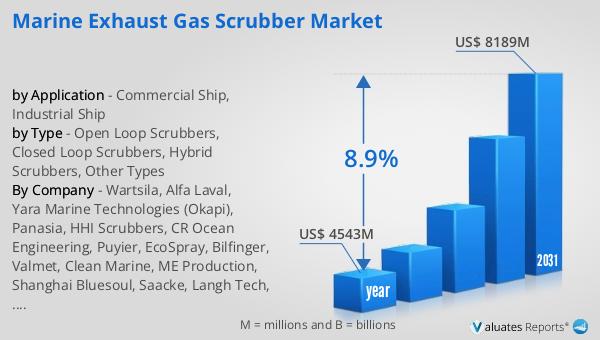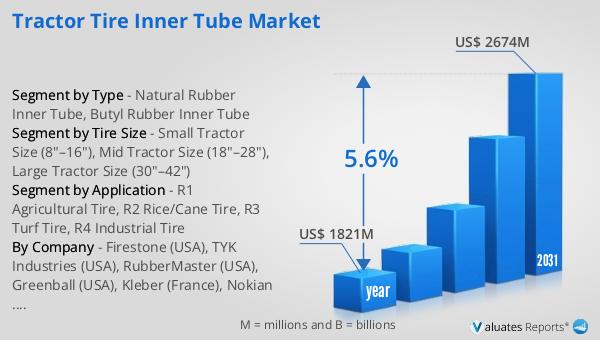What is Global Marine Exhaust Gas Scrubber Market?
The Global Marine Exhaust Gas Scrubber Market is a specialized segment within the maritime industry focused on reducing the environmental impact of ships. These scrubbers are systems installed on ships to clean exhaust gases before they are released into the atmosphere. The primary purpose of these scrubbers is to remove sulfur oxides (SOx) from the ship's exhaust, which are harmful pollutants contributing to acid rain and air pollution. The market for these scrubbers has grown significantly due to stringent international regulations, such as the International Maritime Organization's (IMO) 2020 sulfur cap, which mandates a reduction in sulfur content in marine fuels. This regulation has driven shipowners to adopt exhaust gas cleaning systems as a cost-effective solution to comply with environmental standards. The market encompasses various types of scrubbers, including open loop, closed loop, and hybrid systems, each offering different operational benefits and limitations. As the shipping industry continues to seek sustainable practices, the demand for marine exhaust gas scrubbers is expected to rise, making it a crucial component in the global effort to reduce maritime pollution.

Open Loop Scrubbers, Closed Loop Scrubbers, Hybrid Scrubbers, Other Types in the Global Marine Exhaust Gas Scrubber Market:
Open loop scrubbers are one of the most commonly used types of marine exhaust gas cleaning systems. They operate by using seawater to wash the exhaust gases, effectively removing sulfur oxides. The process involves drawing in seawater, which is then sprayed into the exhaust stream. The sulfur oxides react with the water to form sulfuric acid, which is neutralized by the natural alkalinity of the seawater. The treated water is then discharged back into the sea, along with the neutralized sulfur compounds. Open loop systems are favored for their simplicity and lower operational costs, as they do not require additional chemicals or freshwater. However, their use is restricted in certain areas where discharge of wash water is prohibited due to environmental concerns. Closed loop scrubbers, on the other hand, recirculate the wash water within the system, using an alkaline additive, such as caustic soda, to neutralize the sulfur oxides. This type of system is beneficial in areas where open loop discharge is not allowed, as it does not release wash water into the sea. The closed loop system requires more maintenance and operational oversight due to the need for chemical handling and waste disposal. Hybrid scrubbers combine the features of both open and closed loop systems, offering flexibility to switch between modes depending on the environmental regulations of the area. This adaptability makes hybrid systems attractive to shipowners who operate in diverse regions with varying environmental laws. Other types of scrubbers include dry scrubbers, which use a dry sorbent material to capture sulfur oxides, and membrane scrubbers, which employ membrane technology for gas cleaning. Each type of scrubber has its own set of advantages and challenges, influencing the choice of system based on the specific needs and operational patterns of the vessel.
Commercial Ship, Industrial Ship in the Global Marine Exhaust Gas Scrubber Market:
The usage of Global Marine Exhaust Gas Scrubber Market in commercial ships is primarily driven by the need to comply with international environmental regulations while maintaining operational efficiency. Commercial ships, such as container ships, bulk carriers, and tankers, are significant contributors to global shipping emissions. By installing exhaust gas scrubbers, these vessels can continue to use heavy fuel oil, which is more cost-effective than low-sulfur alternatives, while still meeting the sulfur emission limits set by the IMO. This allows shipowners to manage fuel costs effectively without compromising on environmental compliance. In industrial ships, such as offshore supply vessels, research ships, and specialized cargo carriers, the adoption of marine exhaust gas scrubbers is influenced by both regulatory requirements and the operational environment. Industrial ships often operate in sensitive ecological areas where stricter environmental standards are enforced. The use of scrubbers enables these vessels to minimize their environmental footprint, ensuring that their operations do not adversely impact the surrounding marine ecosystems. Additionally, the ability to switch between different types of scrubber systems, such as hybrid models, provides industrial ships with the flexibility to adapt to varying regulatory landscapes and operational conditions. This adaptability is crucial for maintaining compliance and operational efficiency in diverse maritime environments.
Global Marine Exhaust Gas Scrubber Market Outlook:
The global market for Marine Exhaust Gas Scrubber was valued at US$ 4,543 million in 2024 and is projected to reach a revised size of US$ 8,189 million by 2031, growing at a compound annual growth rate (CAGR) of 8.9% during the forecast period. This growth reflects the increasing demand for effective solutions to meet stringent environmental regulations in the maritime industry. Leading the market are key manufacturers such as Wartsila, Yara Marine Technologies (Okapi), HHI Scrubbers, Alfa Laval, and Panasia, which together account for approximately 52% of the global market share. These companies are at the forefront of innovation and development in exhaust gas cleaning technologies, providing shipowners with reliable and efficient systems to reduce sulfur emissions. The competitive landscape of the market is characterized by continuous advancements in scrubber technology, aimed at enhancing performance, reducing operational costs, and ensuring compliance with evolving environmental standards. As the shipping industry continues to prioritize sustainability, the role of marine exhaust gas scrubbers is expected to become increasingly significant, driving further growth and development in this market segment.
| Report Metric | Details |
| Report Name | Marine Exhaust Gas Scrubber Market |
| Accounted market size in year | US$ 4543 million |
| Forecasted market size in 2031 | US$ 8189 million |
| CAGR | 8.9% |
| Base Year | year |
| Forecasted years | 2025 - 2031 |
| by Type |
|
| by Application |
|
| Production by Region |
|
| Consumption by Region |
|
| By Company | Wartsila, Alfa Laval, Yara Marine Technologies (Okapi), Panasia, HHI Scrubbers, CR Ocean Engineering, Puyier, EcoSpray, Bilfinger, Valmet, Clean Marine, ME Production, Shanghai Bluesoul, Saacke, Langh Tech, AEC Maritime, PureteQ |
| Forecast units | USD million in value |
| Report coverage | Revenue and volume forecast, company share, competitive landscape, growth factors and trends |
